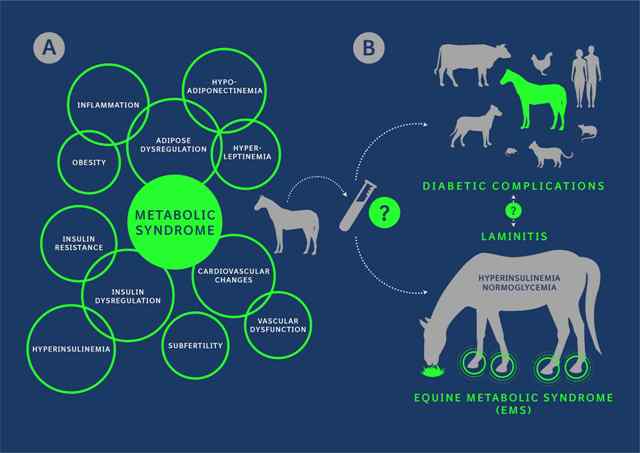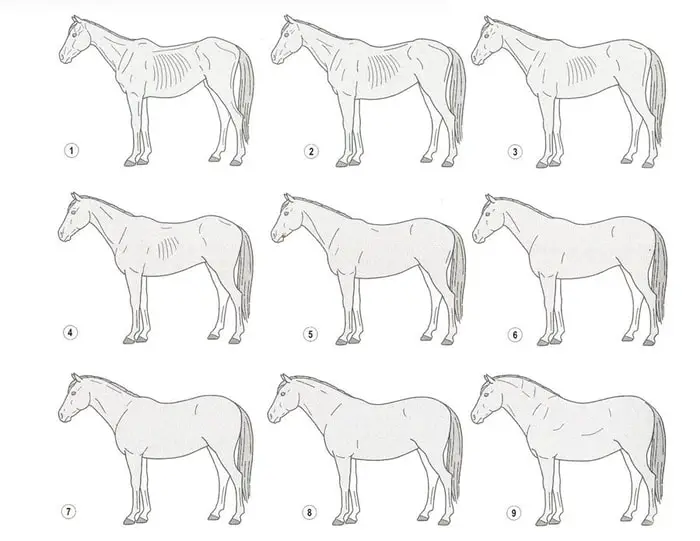Equine Metabolic Syndrome is an endocrine disorder that mainly affects in three ways; excessive fat deposition, dysregulation of insulin, and laminitis. The condition is associated with excessive insulin production, deposition of adipose tissues, and less body weight loss.
Importance of Equine Metabolic Syndrome
Laminitis is the most significant problem that arises from the EMS. Equine Metabolic Syndrome is the clinicopathologic and clinical signs resulting from excessive insulin production. Insulin is a hormone produced by the pancreas that requires glucose uptake within the cells from blood vessels. EMS was found in both horses and ponies.
Causes of Metabolic Syndrome in Horses
The exact causes of Equine Metabolic Syndrome are unknown. The underlying causes are as follows:
- Genetic factors.
- Environmental factors and physiological parameters.
Predisposing Factors of Equine Metabolic Syndrome
The Predisposing Causes of EMS are as follows:
- Obesity.
- High carbohydrate diet.
- Lack of exercise.
- Lack of metabolism.
- Fat deposition in the neck crest, the base of the tail, shoulder, and mammary glands.
Horse Breeds Predispose to EMS
Both donkeys, horses, and ponies are affected by Equine Metabolic Syndrome. The following breeds of horses have commonly affected EMS:
The Thoroughbred and Standardbred horses are comparatively less affected by EMS. Horses aged from 5 to 15 years are commonly vulnerable to EMS.
Clinical Signs of Equine Metabolic Syndrome
The most prominent clinical signs of Equine Metabolic Syndrome are dysregulation of insulin activity and obesity in horses. The other clinical manifestations are as follows:
- Body condition score (BCS) is more than 6.
- Respond to IV glucose injection.
- Excessive fat deposition at the neck’s crest, over the ribs, at the base of the tail, and in mammary glands.
- Affected animals are at high risk of laminitis.
- Increased appetite in affected horses.
- Abnormal reproductive cycle and infertility in mares.
- Horses with EMS must be monitored for Pituitary Pars Intermedia Dysfunction (PPID) or Equine Cushing Disease.
Diagnosis of EMS
The usual diagnosis methods of Metabolic Syndrome in horses are as follows:
- Clinical History and presence of predisposing factors.
- Specific clinical signs.
- Determination of blood glucose and insulin.
- Blood insulin is more than 50 uU/ml, and the horse is diagnosed with insulin dysregulation.
Treatment of Equine Metabolic Syndrome
The principal treatment strategies of EMS are dietary management.
- Restriction of feeding non-structural carbohydrates (NSC).
- Restriction in total calorie intake.
- The restriction in pasture access.
- Increase exercise.
- You can give thyroxine or metformin if the diet restriction or exercise is insufficient.
Prevention of Metabolic Syndrome in Horse
The preventive measures that you can follow for Metabolic Syndrome in horses are:
- Maintain a healthy body weight for the horse.
- Restriction of excessive carbohydrate intake.
- Maintain a balanced exercise daily.
Final Talk on Equine Metabolic
Metabolic syndrome in horses is common in certain breeds and age groups. The condition manifests in insulin dysregulations, excessive fat deposition, and laminitis. The condition can e prevented y following some measures.





